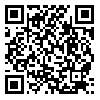Volume 9, Issue 43 (12-2021)
erj 2021, __(43): 123-145 |
Back to browse issues page
Research code: A-10-3593-1
Download citation:
BibTeX | RIS | EndNote | Medlars | ProCite | Reference Manager | RefWorks
Send citation to:



BibTeX | RIS | EndNote | Medlars | ProCite | Reference Manager | RefWorks
Send citation to:
The effect of using educational multimedia in storytelling on enhancing the creativity of fourth grade elementary school students in Downtown, Susangerd. erj 2021; 9 (43) : 4
URL: http://erj.khu.ac.ir/article-1-913-en.html
URL: http://erj.khu.ac.ir/article-1-913-en.html
Abstract: (11926 Views)
The purpose of the present study was to investigate the effect of using educational multimedia in storytelling on increasing the creativity of fourth grade elementary school students in the downtown area of Susangerd in 2019. The statistical population studied in this study was 109 male elementary school students in the downtown area of Susangerd city in the academic year 97-98. The sample size was 85 students according to Cochran formula and 50 students were selected by convenience sampling method and were divided into two groups (25 experimental and group, 25 control group). The semi-experimental research method is pre-test and post-test. The research instrument was the standard Torrance Creativity Testing Questionnaire (1979). The experimental group received 8 sessions of 30-minute storytelling experiment with multimedia teaching tools. The collected data were analyzed by SPSS 24 software. Statistical methods of t-test and U-test were performed. In the above instrument, the coefficient was 95%. The results showed that the use of educational multimedia in storytelling affects the creativity of fourth grade elementary school students in the downtown area, in other words, the use of educational multimedia in storytelling on fluidity, initiative, and flexibility. And it affects the development of students.
Article number: 4
Type of Study: Research Paper |
Subject:
Educational Programing
Received: 2020/11/28 | Revised: 2023/11/21 | Accepted: 2021/12/19 | ePublished: 2021/12/26
Received: 2020/11/28 | Revised: 2023/11/21 | Accepted: 2021/12/19 | ePublished: 2021/12/26
References
1. Abraham. A. (2019).The neuropsychology of creativity, Current Opinion in Behavioral Sciences, Volume 27, June 2019, Pages 71-76. [DOI:10.1016/j.cobeha.2018.09.011]
2. Alexander, B. (2011). The new digital storytelling: Creating narratives with new media. Santa Barbara: Praeger.
3. Anderson and Puay Hoe Chua (2010). Digital Storytelling as an Interactive Digital Media Context. Educational Technology. Vol. 50, No. 5 (September-October 2010), pp. 32-36.
4. Brandon Koh. (2019). A time for creativity: How future-oriented schemas facilitate creativity, Journal of Experimental Social Psychology, Volume 84, September 2019, Article 103816. [DOI:10.1016/j.jesp.2019.103816]
5. Catala. A (2017). Storytelling as a Creative Activity in the Classroom. ACM ISBN 978-1-4503-4403-6/17/06. http://dx.doi.org/10.1145/3059454.3078857. [DOI:10.1145/3059454.3078857]
6. Espierling, U. et al. (2002). Setting the Scene: Playing Digital Director in Interactive Storytelling and Creation. Computers & graphics, 26 (1), 31-44. [DOI:10.1016/S0097-8493(01)00176-5]
7. Javier Gomez (2019). Digital storytelling for good with Tappetina game, Entertainment Computing, Volume 30, May 2019, Article 100297. [DOI:10.1016/j.entcom.2019.100297]
8. Lowenthal, P. R. & Dunlap, J. (2010). From Pixel on a Screen for Real Person in Your Students' Lives: Establishing Social Presence Using Digital Storytelling. The Internet and Higher Education, 13 (1,2), 70-72. [DOI:10.1016/j.iheduc.2009.10.004]
9. Lowenthal, P. R. (2008). Online faculty development and storytelling: An unlikely solution to improving teacher quality. MERLOT Journal of Online Learning and Teaching, 4(3), 349-356.
10. Lwin.S (2017). Narrativity and creativity in oral storytelling: Co-constructing a story with the audience, journal of Language and Literature, Vol 26, Issue 1. Pp 56-88. [DOI:10.1177/0963947016686602]
11. Meihua QianIs (2019). creativity domain specific or domain general? Evidence from multilevel explanatory item response theory models, Thinking Skills and Creativity, Volume 33, September 2019, Article 100571. [DOI:10.1016/j.tsc.2019.100571]
12. Psomos, P. & Kordaki, M. (2012). Pedagogical Analysis of Educational Digital Storytelling Environment of the Last Five Years. Procedia-Social and Behavioral Sciences, 46, 1213-1218. [DOI:10.1016/j.sbspro.2012.05.277]
13. Rajabi, S & Khosravi. A. (2018). Investigating the effect of creative storytelling on enhanced creativity of preschool students in Iran, Journal of Poetry Therapy, The Interdisciplinary Journal of Practice, Theory, Research and Education, Volume 31, 2018 - Issue 4. [DOI:10.1080/08893675.2018.1504706]
14. Renzulli, K.S. (1993). Through the pursuit of ideal act of learning gifted.Child Quarterly, Vol. 36, No. 4, 56-60. [DOI:10.1177/001698629203600402]
15. Rühlemann.C. (2019). Alternating gaze in multi-party storytelling, Journal of Pragmatics, Volume 149, August 2019, Pages 91-113. [DOI:10.1016/j.pragma.2019.06.001]
16. Sadik, A. (2008). Digital storytelling: A meaningful technology-integrated approach for engaged student learning. Educational Technology Research and Development, 56(4), 487-506. [DOI:10.1007/s11423-008-9091-8]
17. Schmoelz.A (2018). Enabling co-creativity through digital storytelling in education, Thinking Skills and Creativity, Volume 28, June 2018, Pages 1-13. [DOI:10.1016/j.tsc.2018.02.002]
18. Tang. Sh. (2016). Digital Storytelling Approach in a Multimedia Feature Writing Course. Journal of Language Teaching and Research, Vol. 7, No. 3, pp. 572-578, May 2016DOI: http://dx.doi.org/10.17507/jltr.0703.19. [DOI:10.17507/jltr.0703.19]
19. Tomkins, A. (2009). "It was a great day when…": An exploratory case study of reflective learning through storytelling. Journal of Hospitality, Leisure, Sport & Tourism Education, 8(2), 123-131. [DOI:10.3794/johlste.82.198]
20. Torrance, E. P., & Goff, K. (1989). A quiet revolution. Journalof Creative Behavior, 23, 136-145. [DOI:10.1002/j.2162-6057.1989.tb00683.x]
21. Tsou, W.; Wang, W. & Tzeng, Y. (2006). Applying a Multimedia Storytelling Website in Foreign Language Learning. Computers and education, 47 (1), 17-28. [DOI:10.1016/j.compedu.2004.08.013]
22. Wang, D., Li, J., & Dai, G. (2008). A pen and speech-based storytelling system for Chinese children. Computers in Human Behavior, 24, 2507-2519. [DOI:10.1016/j.chb.2008.03.014]
23. Yang, Y. & Wu, W. (2012). Digital Storytelling for Enhancing Student Academic Achievement, Critical Thinking, and Learning Motivation: A Year-Long Experimental Study. Computers and education, 59 (2), 339-352. [DOI:10.1016/j.compedu.2011.12.012]
| Rights and permissions | |
 |
This work is licensed under a Creative Commons Attribution-NonCommercial 4.0 International License. |



